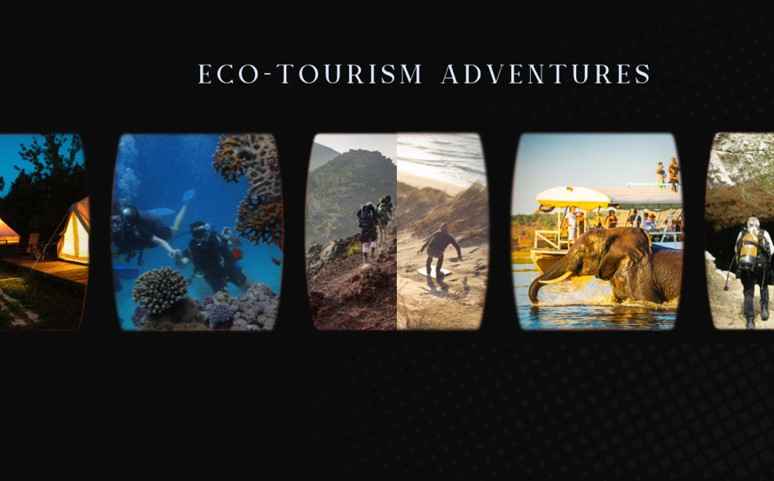
Hey there, nature nerds and travel addicts! You know how eating a whole cake feels amazing but makes you feel guilty later? That’s kind of like traditional tourism—it’s fun, but it certainly leaves a mark on the environment and other cultures.
Good news! You can still have great adventures without making Mother Earth sad. It’s called eco-tourism, otherwise known as travel, that’s good for you and the planet.
So, what’s in this article? We’ll talk about different kinds of eco-tourism—you’ll be surprised, there’s a lot! We’ll also tell you why it’s good for the planet and the people who live where you’re visiting. And, of course, tips for planning your eco-friendly trip. You won’t want to miss this!
Eco-tourism. What is it? Well, it’s a type of tourism that is all about traveling in a way that respects nature and the local people. Unlike regular tourism, where it’s often just “snap and go,” eco-tourism sticks around to make a positive impact. It’s the friend who helps clean up after a party, not the one who just eats all the chips and leaves.
These simple principles of eco-tourism ensure you’re not just a tourist but a responsible traveler making a positive impact on other cultures and the land.
Eco-tourism is not some hippie daydream but rather the wise elder in the tourism family. People were whispering about respecting nature while traveling as far back as, well when travel became a thing! But let’s mark the 1980s as when it went mainstream—like mullets but with a better lasting impression. Fast forward to the present day, where this form of tourism is not just a trend but a necessity. More and more people are hopping on the eco-train, and trust me, this one’s not going out of style.
Eco-tourism is good for the Earth. When you travel this way, you help protect nature. For example, the money you spend can go towards keeping a national park clean and safe. It’s a way to enjoy nature without hurting it.
Eco tourism is also good for local people. It helps bring money to small businesses and keeps local traditions alive. You learn a lot, and the locals get something positive out of it as well.
Last but not least, eco tourism is good for you. You can learn new things, feel closer to nature, and even feel happier and calmer. It’s like a win-win for everyone— you, the planet, and the people living in the places you visit.
Now let’s take a look at a variety of different types of eco tourism to inspire your next journey.
Ever wanted to meet Simba or Dumbo in real life? Wildlife safaris let you hang out with animals in their natural home—not in a cage or behind glass walls. If you’re going on a safari, consider a vehicle attachment designed for low environmental impact to further minimize your footprint. You can do this in places like Kenya, Tanzania, or even India for a chance to see tigers.
If you love to move your legs and get that heart rate up, hiking and nature trails are your BFFs. Imagine trekking through the Himalayas or hiking up the Appalachian Trail in the U.S. Your Instagram will be so green with nature photos that people will think you are part plant.
Love the water but are tired of the chlorine smell in pools? Go snorkeling in the Great Barrier Reef or kayaking in the bioluminescent bays of Puerto Rico. You’re not just splashing around; you’re literally swimming with Nemo.
What if you could live like the locals and help them out at the same time? Community-based eco tourism lets you do just that. For instance, you can help build sustainable housing in Thailand or teach English in a rural school in Africa.
Get your binoculars ready! Locations like the Amazon Rainforest or Australia’s Kakadu National Park are a bird lover’s heaven. But don’t be that guy who scares the birds away; the idea is to watch, not interact.
Also known as Shinrin-yoku in Japan, this isn’t your typical splash in the tub. It’s about being in the forest and absorbing its natural beauty. Think of it as a spa day for your soul.
Destinations like Iceland and the coast of California offer responsible whale-watching tours that do not disturb these magnificent creatures. It’s like watching a live Nat Geo episode, but way cooler.
From replanting forests in the Amazon to protecting turtle nests in Costa Rica, some programs let you give back while you travel. You can claim you saved a species on your next Tinder date.
Yeah, it’s a thing! In places like New Zealand, you can learn to fish in a way that respects marine life and local regulations. Perfect if you’re angling for a good time without being a fish’s worst nightmare.
Delve deep into the Earth’s belly responsibly in locations like Slovenia’s Škocjan Caves or Kentucky’s Mammoth Cave. No disturbing bat habitats, please; we’ve all seen enough Batman reboots.
Who said camping can’t be glamorous and sustainable? Locations like South Africa’s Kruger National Park offer luxurious tents with minimal environmental impact. It’s like the Ritz-Carlton of camping.
Do it sustainably in places like Namibia. It’s basically surfing but without the wet suit and with a lot more sand in your shoes.
Eco-tourism is like the superhero version of tourism. It’s all about saving the world while we jet-set across it. This sustainable form of travel focuses on preserving and appreciating natural environments. No, we’re not talking about petting the trees and whispering sweet nothings to the flowers (although, feel free to do that if it floats your boat).
First of all, it’s all about promoting environmental conservation. Because let’s face it, Mother Nature needs all the help she can get these days. We’re here to ensure that our tourism activities don’t harm the precious ecosystems we’re lucky enough to explore. Plus, eco-tourism is all about supporting local communities. None of us want to travel to a place that’s been turned into a corporate tourist trap, right? And on top of all that, it raises awareness about the importance of biodiversity.
The main difference is that eco-tourism is like the Hermione Granger of travel. It’s all about being responsible, environmentally-conscious, and involving the local community. We emphasize sustainable travel practices, minimal environmental impact, and even throw in a bit of education and conservation for good measure. Traditional tourism, on the other hand, is like that person who leaves their trash on the beach and tramples on fragile ecosystems just to get a selfie.
The key principles of eco-tourism are the backbone of this movement, my fierce eco-warriors. We’re talking about minimizing our environmental impact, respecting local cultures, supporting conservation efforts, providing meaningful experiences for our precious little selves, and hey, let’s not forget about benefiting local communities economically.
Just choose responsible tour operators who give a damn about sustainability. Follow the Leave No Trace principles – because let’s be honest, who wants to leave their trash behind like some kind of litter-obsessed animal? Respect local cultures, minimize waste (we’re not here for single-use plastic, people), and stay in accommodations that prioritize sustainability. It’s time to put our money where our mouth is and say “I support eco-tourism, damn it!”
You bet your fabulous backpack there are certification programs for eco-friendly accommodations and tour operators. We’re talking about EarthCheck, Green Key, Rainforest Alliance, and more. These programs evaluate and certify businesses in the tourism industry for their commitment to sustainability. So you can sleep easy knowing your eco-friendly choices are backed up by some serious credentials.
We’re talking about the Galápagos Islands in Ecuador, where strict regulations protect the unique biodiversity of that place. It’s like stepping into a real-life natural wonderland. And hey, let’s not forget about Costa Rica. This country is known for its extensive network of national parks and wildlife reserves. It’s like a paradise for nature lovers. These are just a few examples of how eco-tourism can make a big impact and protect these incredible places for generations to come.
We’ve walked you through the what, why, and how of eco tourism, and let me tell you, it’s not just a niche; it’s the future of travel. Whether you’re into wildlife safaris, underwater adventures, or simply soaking in the beauty of a forest, eco-tourism offers something for everyone. But the biggest perk? You can have all this fun while knowing you’re doing your bit for the planet and its people.
Choosing eco-tourism is choosing to travel with awareness and responsibility. It’s about turning your vacation into a force for good, benefitting not only you, but also the local communities and Mother Earth herself. So, the next time you’re itching to pack those bags and jet off, remember to include sustainability in your plans. Your future self and the future generations will thank you for it.
But no matter where you go or what you choose, always remember to Travel Till You Drop!
Use Skyscanner to find a cheap flight. This is my very first stop when I’m looking for my next trip. It’s a fast, easy-to-use search engine that is perfect for finding an affordable flight, a perfect hotel, and the right rental car for you in locations around the globe.
If you are looking for a super budget friendly location and are open to a hostel stay, make sure you book your hostel with Hostelworld. It offers the broadest range of quality hostels around the world.
If you’d prefer a hotel or a guesthouse for stays less than 28 days, drop on over to Booking.com It’s perfect for providing excellent options, a ton of user reviews, and prices to fit every budget.
For stays over 28 days, AirBnB still remains my #1 choice. User reviews and monthly pricing allow for some incredible deals all around the world.
Travel insurance is but a small up-front investment that you won’t want to leave home without. After just one experience of having to delay or cancel your trip or having your luggage stolen, you’ll wish you would have made that investment. I’ve hated my life a few times when the moment arose, and I decided to skip out. Let’s just say, I’ve changed my ways and recommend each of the following companies to protect your ass-ets.
Travel credit cards allow you to earn points that can be redeemed for free flights and accommodation — all without any extra spending. Check out my guide to getting free flights to get started.
Check out my Resource Page for the best companies to help you book your travel at reduced rates! This list will help you get to where you’re going. I know-I use them ALL the time!


Hi, Jill Here
Hi! I’m Jill, a Dallas, Texas girl traveling the world. After a career in the Air Force and touring over 50 countries later, my need to explore keeps going! It’s time to rock & roll and find all those places I never knew I was missing.
Table of Contents
Join me to get exclusive travel tips, giveaways and more!
Gallery
Copyright © 2023 | All Right Reserved